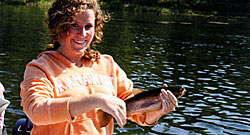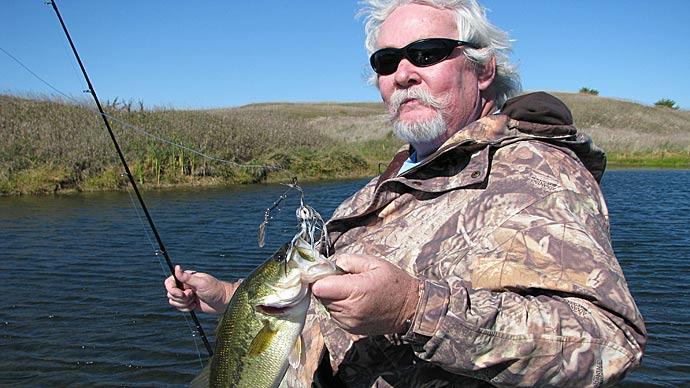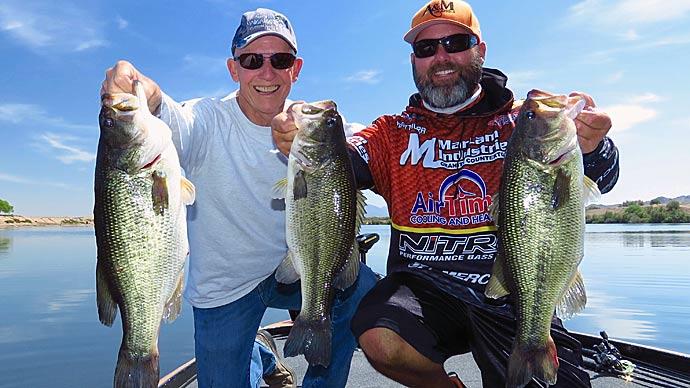
I'll always remember walking into Dr. Mark Griffin's cubicle at Purina Mills' headquarters in St. Louis, Missouri. It was spring, 2006 and Griffin had a smile about a mile wide. We greeted each other, he offered a seat. I accepted.
Then, he reached into a desk drawer and pulled out a sandwich-size baggie with a little two ounce, brown, long nugget in the bottom. I tried not to wonder aloud, but it reminded me of what Queen Debbie's lap dog, our Yorkie, leaves on the porch for me to sweep away.
"What's that?" I asked him.
"A trout," he retorted.
"A what?" I couldn't wait to hear this story.
Griffin, at the time in charge of aquatic feeds for Purina, explained. His educational roots are based in aquaculture and nutrition, but his heart lies at the business end of a fishing rod. Seems he had seen the photos racing around the Internet at the time of a giant largemouth bass foul-hooked in a California lake. That monster-bass weighed 25 pounds.
That giant bass provided the impetus for Griffin to do some of his own research. Fisheries managers and anglers all over the United States knew how this bass had grown so large. It made a living off regularly stocked rainbow trout. So, Griffin headed to his local fish market, bought a 12 ounce rainbow trout and headed for the lab. With the lab technicians, his team broke down the nutritional components of the fish. They extracted the water, first. About ten ounces. That trout was more than 80% water. Next, they extracted the fat, and then figured out the protein sources and micronutrients.
Trout may be the "perfect" food for largemouth bass.
Because of his drive and motivation, Purina Mills soon had a new product, AquaMax Largemouth, designed for feed-trained largemouth bass.
What about your non-feed-trained bass?
Consider feeding live rainbow trout.
Think about it this way. Rainbow trout are readily available from commercial hatcheries from North Carolina to Missouri, in Nebraska, Colorado,northern California and most points north. Live haulers bring them into the southern states during late fall and all the way through winter months. Trout are fairly easy to get. Prices range from a high of $9 per pound to as little as $3.25, depending where you live and how far they are trucked.
Let's do some math. Fathead minnows cost as much as $10 per pound. If you pay less than that, you're pretty lucky. It takes ten pounds of minnows for a bass to gain one pound. But, a one pound trout yields just less than four ounces of pure nutrition, close to one and a half times what other fish offer. While that doesn't seem to be much of a savings, there's a huge difference.
You can pick what size bass you want to feed.
Fathead minnows will never get to your target-sized bass. Bluegill and small bass gobble up those tiny hunks of meat.
Feeding Trout to Bass
I'll always remember Mark Hibdon, from Oklahoma City. Mark had a nice 8 acre lake southwest of the city. He had worked hard on his bass fishery, culling small bass, feeding bluegill, supplementally stocking adult bluegill and shad and protecting his biggest bass. He had a nice bass lake, on its way to great. His largest bass fed mostly on medium-sized bass. But, his three pounders seemed to struggle to get to four and beyond.
Hibdon made a bold commitment. He decided to stock 1,000 pounds of rainbow trout into his 8 acre lake in the mid-1990's. We talked it over. Back then, we could have that many fish delivered from central Missouri for around $4.00 per pound.

The more we talked about the prospects, the more we both liked it. Mark asked if we could choose the size of trout we wanted. A quick call to the supplier assured us we could. From several electrofishing trips, plus Mark's excellent catch record data, we saw his dominant size-class of fish was 14 inches. He had a fair number of 16's, 17's and some 18's, but the sizes jumped to 21 and 22 from there. Those big bass were doing quite well, thank you. But, those 2 to 4 pound bass needed a nudge. Because of that fact, we chose to stock 9 to 12 inch rainbow trout.
When the truck arrived in late November, it reminded of the gunfight at the O.K. Corral. When those trout hit the water, bass rejoiced.
Let's do the math...if all those fish were consumed, as is, by selective sizes of largemouth bass, that means 1,000 pounds of trout became 200 pounds of bass. That means he spent about $20 per pound of gain to selectively feed his bass.
Was it worth it?
He thought so. Hibdon was able to selectively target a specific size-class of bass and ignore those bass of lesser value to his goals.
What actually happened was better than the obvious. The bass didn't eat all the trout at once. After all, the water was cool when they were stocked. Trout are frisky creatures at cool temperatures, but bass are not. Bass fed when they were hungry. Hibdon fed the trout a healthy diet, every day. They gained weight. He and his family fished for them and enjoyed catching a good number of them. A ten inch trout isn't bad fare when it comes to light tackle. Several of them made their way into hot peanut oil, after being rolled in corn meal.
As late fall fell into winter, his water temperature dropped and bass were even less active. He had trout feeding well into March and they were growing fairly well. But, something interesting happened. About the second week of March, bluegill began to feed and compete with the trout. It didn't take long, bass began to awaken to the slowly warming temperatures. Bass began to move faster and trout began to slow down. By April, bass had the advantage. By the middle of May, it was all over.
The spring survey, before bass spawned, showed the target size bass had gained significantly over the winter, compared to the years before. In this case, Hibdon's $4,000 investment yielded the results he expected. A number of his bass climbed over the hump, growing into sizes which could effectively compete and have the opportunity to grow into the mega-large sizes he wanted.
Hibdon followed the trout stocking with crawfish stocking in the spring and then focused his efforts on growing as many baitfish naturally in his lake as he could. The following winter he tried the trout again.
But, after that, he had several major changes in his life and this project slowed to a halt. It would have been interesting to follow it for several years.
So, how does this impact your decisions?
If you want to feed trout to your fish, look at the prices, first. See if it's economical for your own pocketbook. Know that you can feed trout to selected sizes of bass. That's a huge plus. If you want to feed your 14 inch bass, you can. If you want to feed only bass larger than 18 inches, you can. Conversion rates approach 20% of the mass you feed. The longer the trout live and grow, the better that conversion rate is. That means it's better to stock a big lot of trout compared to several stockings over a longer period of time. As far as a good food source, trout certainly fill that bill. They are long, slender and easy to swallow. They are nutritionally complete and easy for a bass to catch when water temperatures are above 65 degrees.
Is stocking trout to feed your bass or other game fish a good move?
That's a decision you and your pocketbook need to make. At $9 per pound, you are paying roughly $45 per pound of bass gain. At $6, the math works out to be $30. If you've priced bass at any of the hatcheries around the nation, try buying a five pounder. Even those people who make a living raising fish understand what it takes for a predator game fish to grow to five pounds. Expect to pay beyond $75 for a five pound bass from a producer...on a good day.
Any way you look at it, this whole proposition is expensive.
But, so is a new bass boat. So is a new baitcasting rig.
So is a trip to the coast to try to catch a fish... or three.
So, all this stuff is relative.
If it fits your style, give it a try.
Just do the math, first.
Reprinted with permission from Pond Boss Magazine



